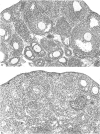Abstract
Previous studies from our laboratory described a particular type of ovarian dysgenesis which develops in mice after neonatal thymectomy (Tx) at the critical age of 2-4 days after birth. The present experiment provides evidence which strongly suggests an autoimmune aetiology for this phenomenon. By indirect immunofluorescence (IFL) and horse-radish peroxidase (HRPO) labelled antibody techniques, it was demonstrated that neonatally Tx mice of (C57B1/6Cr x A/JCr)F1 (B6A) and (C3H/HeMs x 129/J)F1 (C31) hybrids produce circulating autoantibody(ies) against ooplasma of oocytes (AOA) in growing follicles, but not against oocytes in primordial follicles. Appearance of AOA was closely correlated with the development of oophoritis which ws characterized by a rapid and complete loss of oocytes at early adulthood. In B6A and C31 mice, oophoritis occurred and AOA appeared in sera after Tx at day 3(Tx -- 3) but not after Tx at days 0 or 7. Also, in athymic B6A and C31 nude mice neither oophoritis or AOA were detectable. Complete absorption of AOA with homogenates of isogeneic normal adult ovaries, but not with homogenates of X-ray-irradiated anovular ovaries or granulosa cell tumour may indicate the specificity of AOA. AOA was first demonstrated at day 30-40 in sera of Tx mice, whose ovaries showed a marked enhancement of follicular degeneration and the death of numerous occytes with or without lymphocyte infiltration. High titres of AOA, detectable in sera of more than 2,000-fold dilutions, were assayed by the IFL technique at day 50-90; however, AOA gradually diminished in titre with age and disappeared at day 150-360 when no oocytes remained in the atrophic ovary. Mice thymectomized at day 3 occasionally produced autoantibodies against zona pellucida and with lesser frequency against steroid-producing cells of the ovary. These data indicate that in the mouse Tx at the critical age shortly after birth produces autoimmune oophoritis, subsequently resulting in early sterility.
Full text
PDF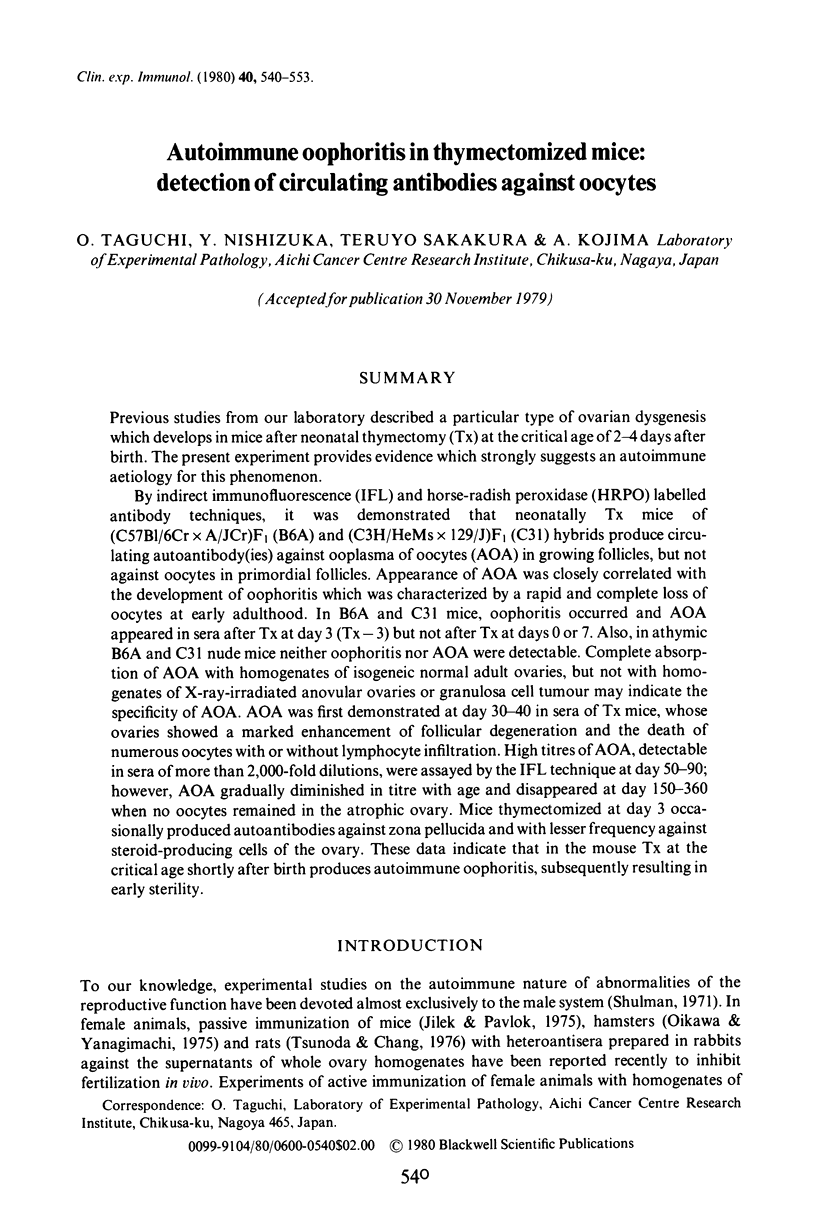
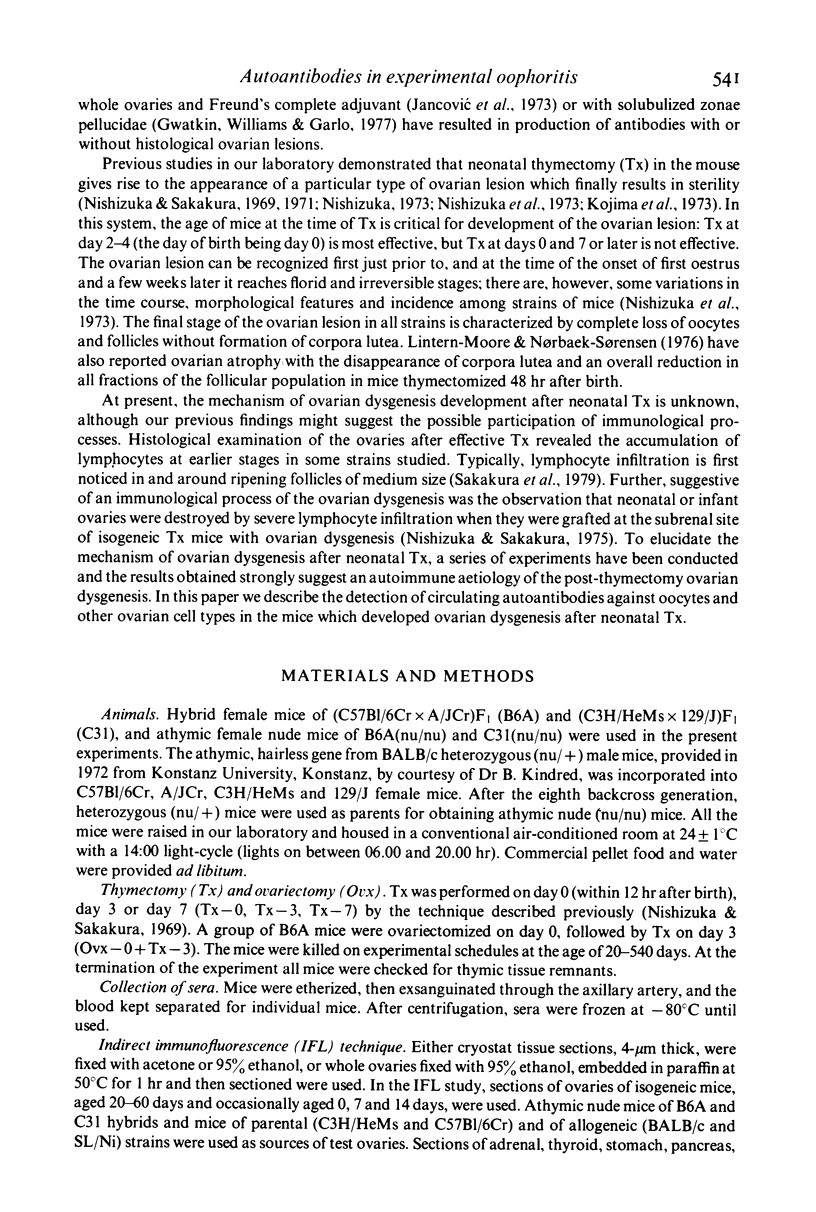

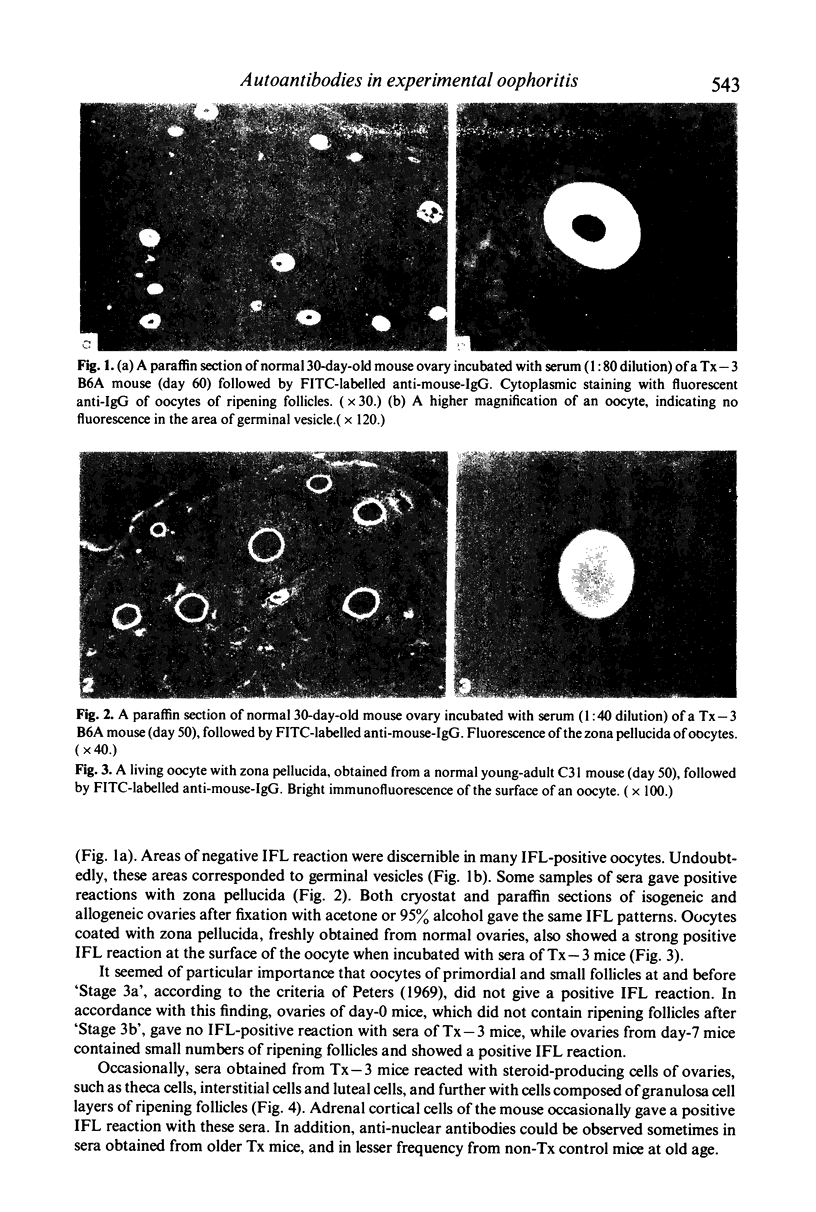
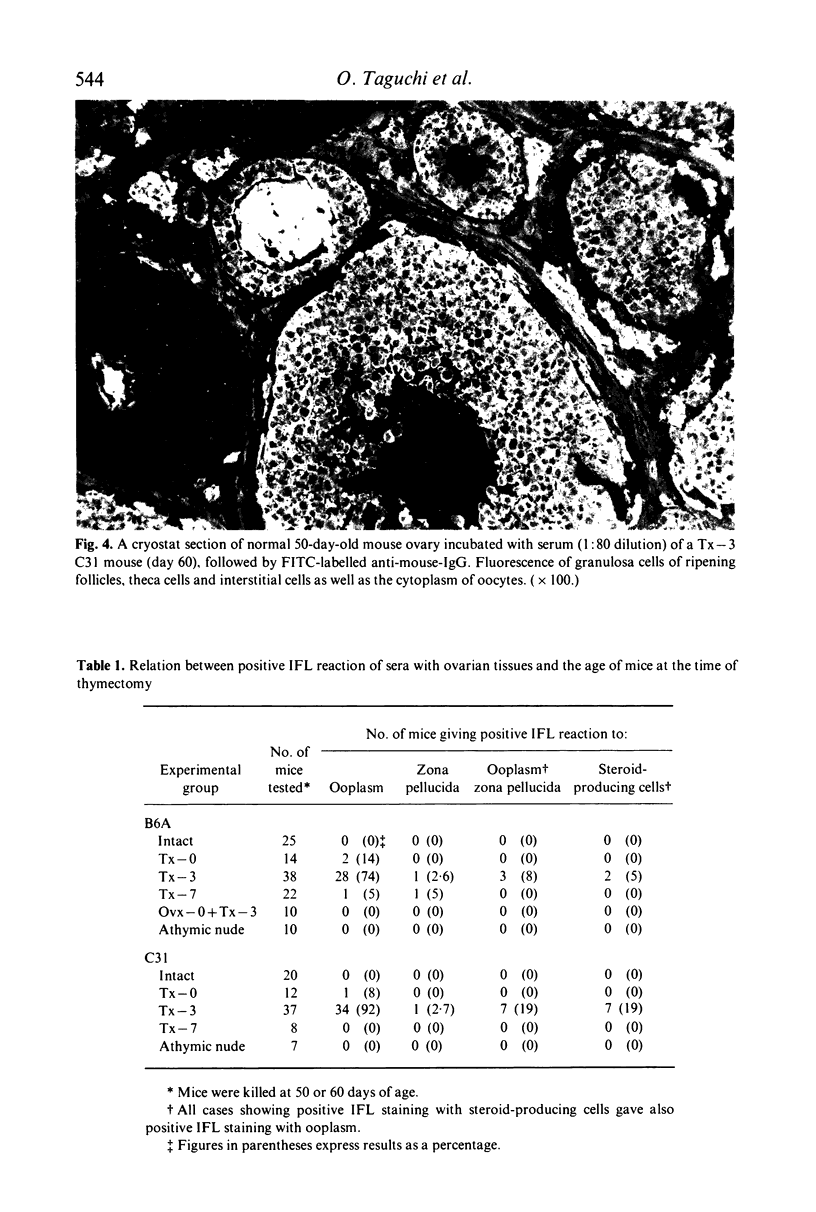



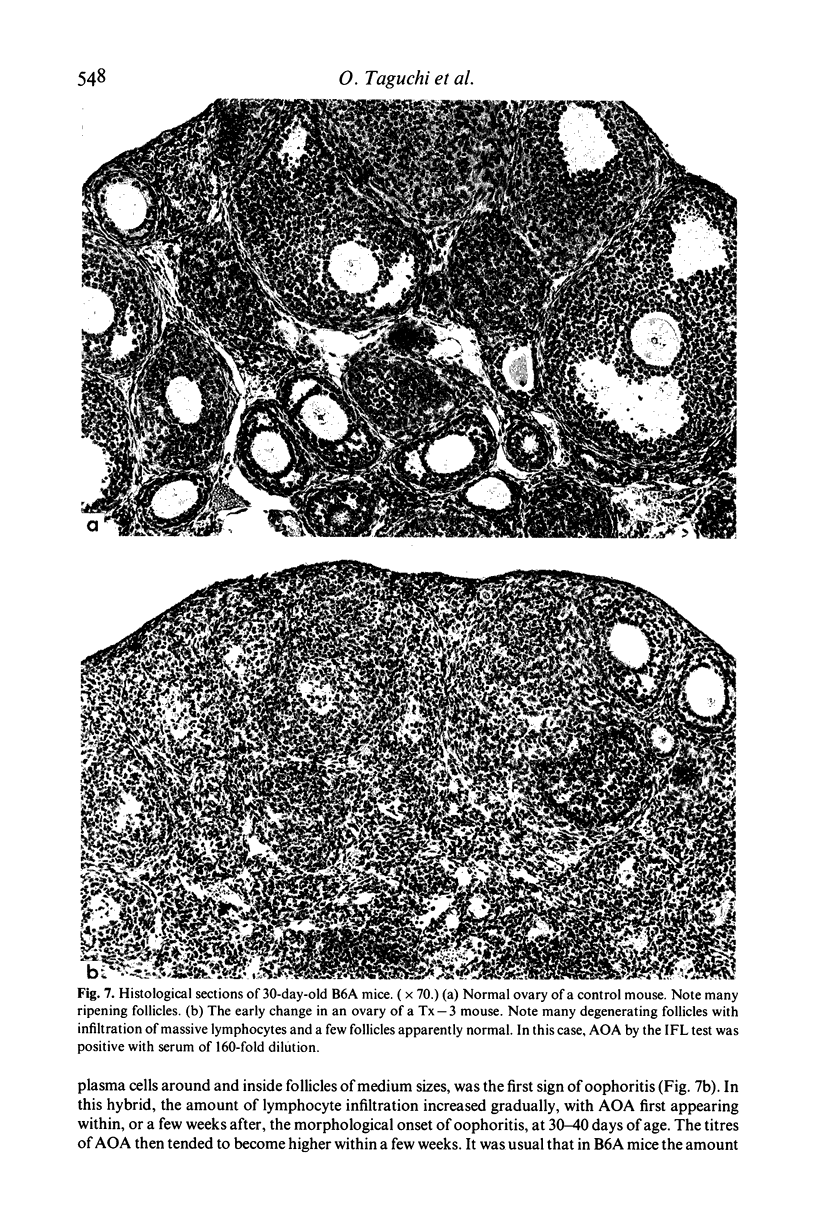

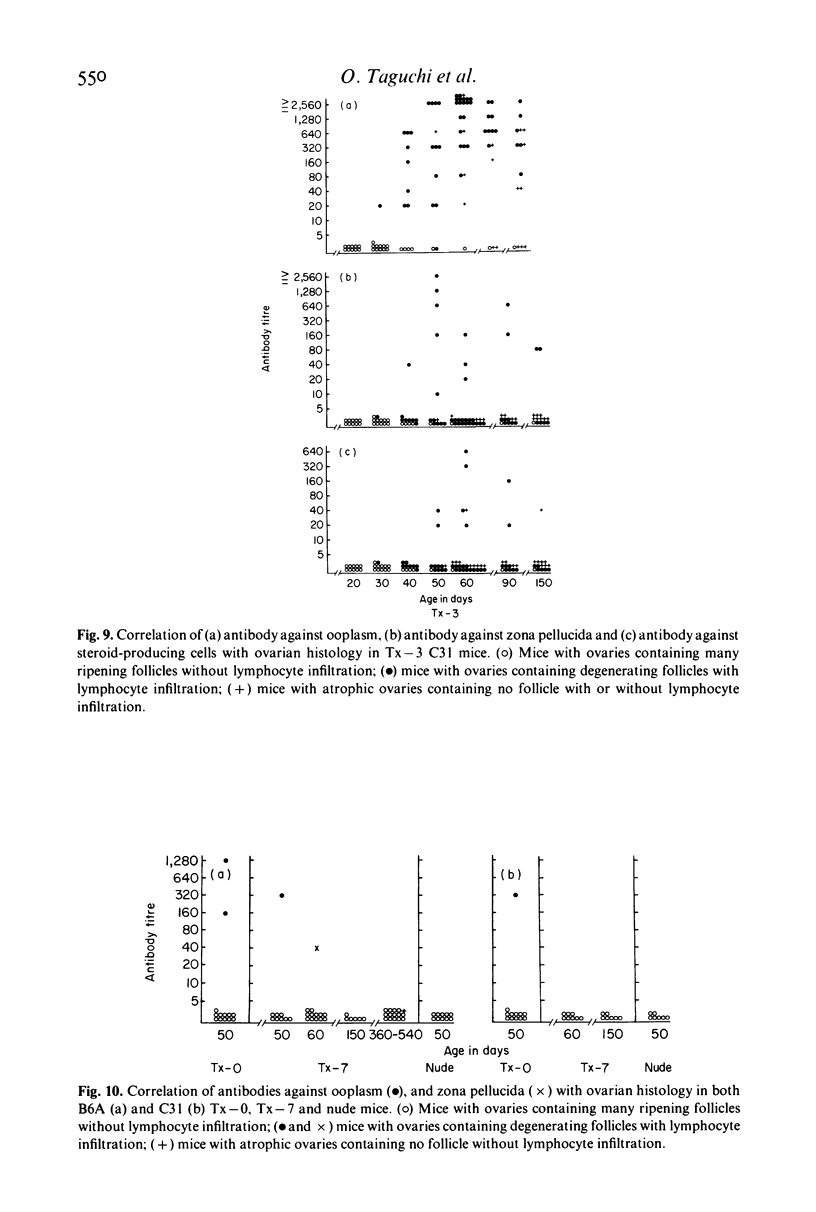
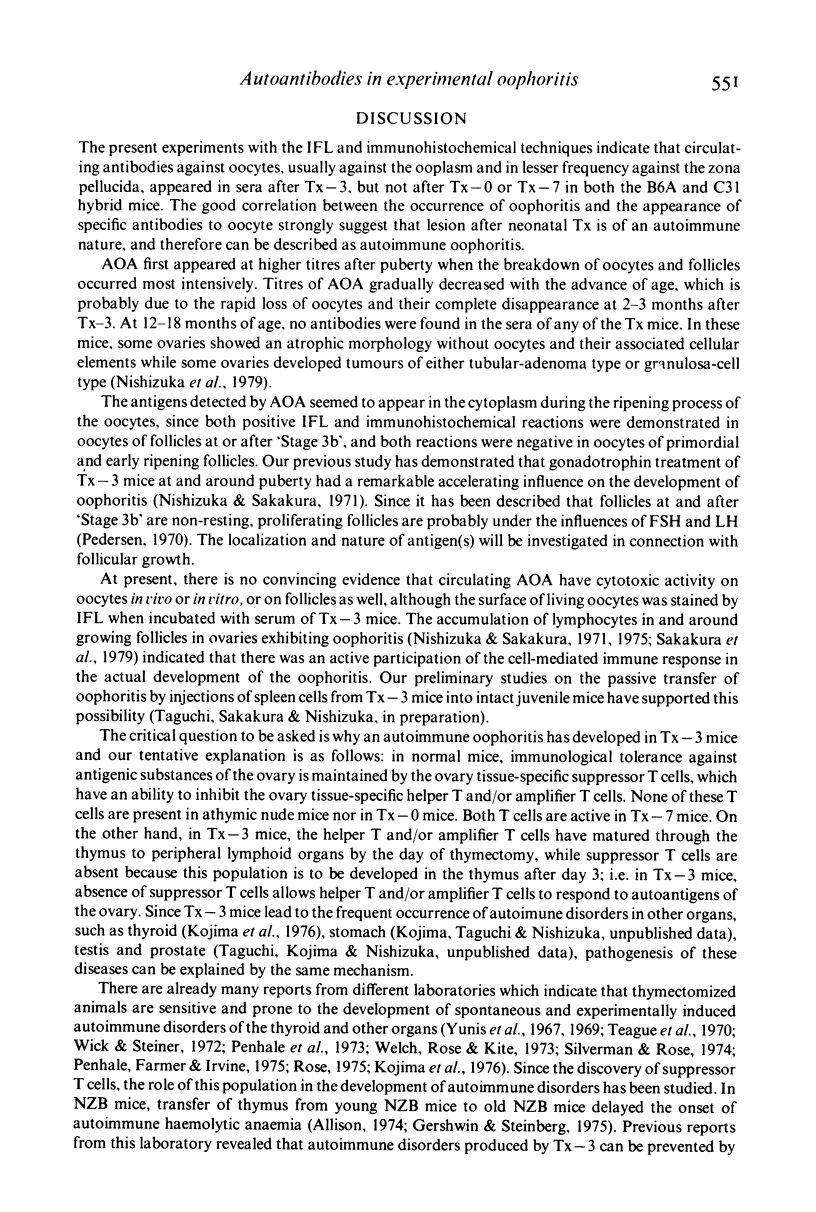
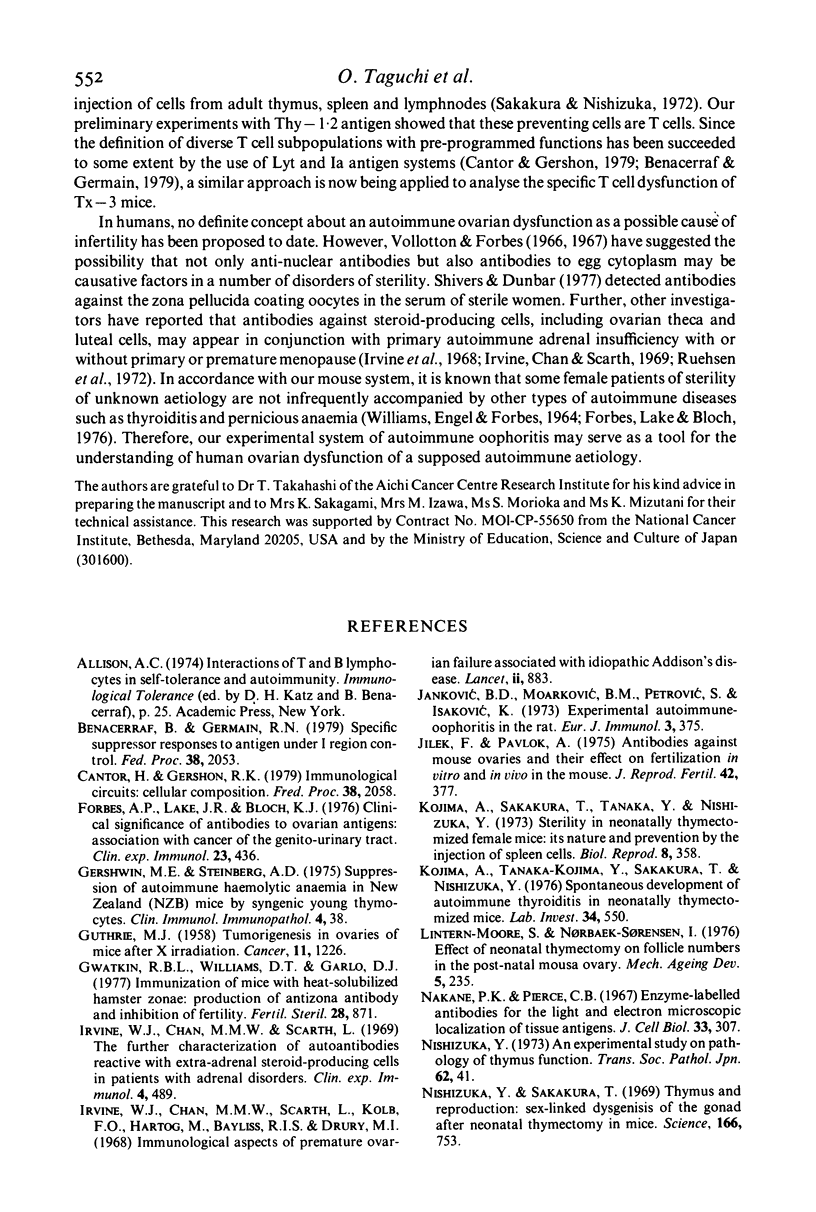
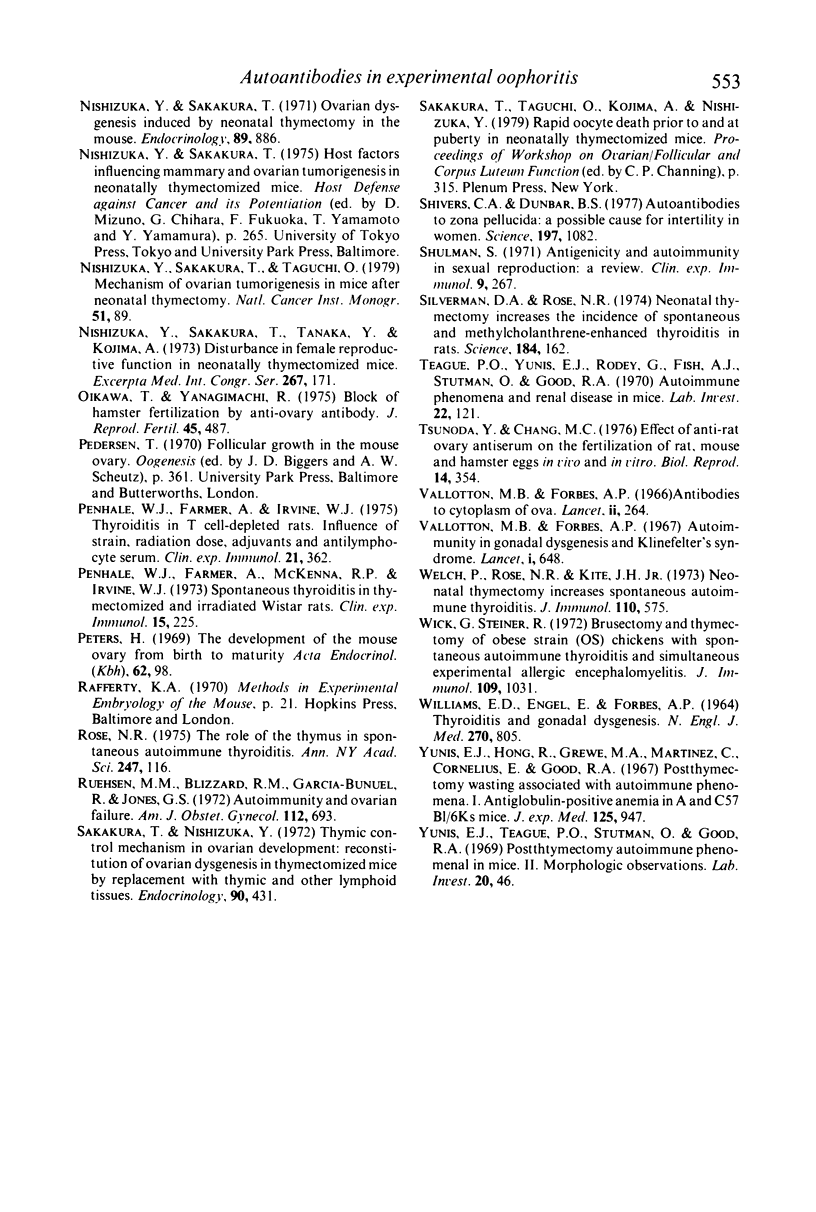
Images in this article
Selected References
These references are in PubMed. This may not be the complete list of references from this article.
- Benacerraf B., Germain R. N. Specific suppressor responses to antigen under I region control. Fed Proc. 1979 Jun;38(7):2053–2057. [PubMed] [Google Scholar]
- Cantor H., Gershon R. K. Immunological circuits: cellular composition. Fed Proc. 1979 Jun;38(7):2058–2064. [PubMed] [Google Scholar]
- Forbes A. P., Lake J. R., Bloch K. J. Clinical significance of antibodies to ovarian antigens; association with cancer of the genito-urinary tract. Clin Exp Immunol. 1976 Mar;23(3):436–443. [PMC free article] [PubMed] [Google Scholar]
- GUTHERIE M. J. Tumorigenesis in ovaries of mice after x irradiation. Cancer. 1958 Nov-Dec;11(6):1226–1235. doi: 10.1002/1097-0142(195811/12)11:6<1226::aid-cncr2820110619>3.0.co;2-f. [DOI] [PubMed] [Google Scholar]
- Gershwin M. E., Steinberg A. D. Suppression of autoimmune hemolytic anemia in New Zealand (NZB) mice by syngeneic young thymocytes. Clin Immunol Immunopathol. 1975 May;4(1):38–45. doi: 10.1016/0090-1229(75)90037-9. [DOI] [PubMed] [Google Scholar]
- Gwatkin R. B., Williams D. T., Carlo D. J. Immunization of mice with heat-solubilized hamster zonae: production of anti-zona antibody and inhibition of fertility. Fertil Steril. 1977 Aug;28(8):871–877. doi: 10.1016/s0015-0282(16)42744-5. [DOI] [PubMed] [Google Scholar]
- Irvine W. J., Chan M. M., Scarth L., Kolb F. O., Hartog M., Bayliss R. I., Drury M. I. Immunological aspects of premature ovarian failure associated with idiopathic Addison's disease. Lancet. 1968 Oct 26;2(7574):883–887. doi: 10.1016/s0140-6736(68)91053-2. [DOI] [PubMed] [Google Scholar]
- Irvine W. J., Chan M. M., Scarth L. The further characterization of autoantibodies reactive with extra-adrenal steroid-producing cells in patients with adrenal disorders. Clin Exp Immunol. 1969 May;4(5):489–503. [PMC free article] [PubMed] [Google Scholar]
- Janković B. D., Marković B. M., Petrović S., Isaković K. Experimental autoimmuno-oophoritis in the rat. Eur J Immunol. 1973 Jun;3(6):375–377. doi: 10.1002/eji.1830030612. [DOI] [PubMed] [Google Scholar]
- Jílek F., Pavlok A. Antibodies against mouse ovaries and their effect on fertilization in vitro and in vivo in the mouse. J Reprod Fertil. 1975 Feb;42(2):377–380. doi: 10.1530/jrf.0.0420377. [DOI] [PubMed] [Google Scholar]
- Kojima A., Sakakura T., Tanaka Y., Nishizuka Y. Sterility in neonatally thymectomized female mice: its nature and prevention by the injection of spleen cells. Biol Reprod. 1973 Apr;8(3):358–361. doi: 10.1093/biolreprod/8.3.358. [DOI] [PubMed] [Google Scholar]
- Kojima A., Tanaka-Kojima Y., Sakakura T., Nishizuka Y. Spontaneous development of autoimmune thyroiditis in neonatally thymectomized mice. Lab Invest. 1976 Jun;34(6):550–557. [PubMed] [Google Scholar]
- Lintern-Moore S., Norbaek-Sorensen I. Effect of neonatal thymectomy on follicle numbers in the post-natal mouse ovary. Mech Ageing Dev. 1976 Jul-Aug;5(4):235–239. doi: 10.1016/0047-6374(76)90023-3. [DOI] [PubMed] [Google Scholar]
- Nakane P. K., Pierce G. B., Jr Enzyme-labeled antibodies for the light and electron microscopic localization of tissue antigens. J Cell Biol. 1967 May;33(2):307–318. doi: 10.1083/jcb.33.2.307. [DOI] [PMC free article] [PubMed] [Google Scholar]
- Nishizuka Y., Sakakura T. Ovarian dysgenesis induced by neonatal thymectomy in the mouse. Endocrinology. 1971 Sep;89(3):886–893. doi: 10.1210/endo-89-3-886. [DOI] [PubMed] [Google Scholar]
- Nishizuka Y., Sakakura T., Taguchi O. Mechanism of ovarian tumorigenesis in mice after neonatal thymectomy. Natl Cancer Inst Monogr. 1979 May;(51):89–96. [PubMed] [Google Scholar]
- Nishizuka Y., Sakakura T. Thymus and reproduction: sex-linked dysgenesia of the gonad after neonatal thymectomy in mice. Science. 1969 Nov 7;166(3906):753–755. doi: 10.1126/science.166.3906.753. [DOI] [PubMed] [Google Scholar]
- Oikawa T., Yanagimachi R. Block of hamster fertilization by anti-ovary antibody. J Reprod Fertil. 1975 Dec;45(3):487–494. doi: 10.1530/jrf.0.0450487. [DOI] [PubMed] [Google Scholar]
- Penhale W. J., Farmer A., Irvine W. J. Thyroiditis in T cell-depleted rats. Influence of strain, radiation dose, adjuvants and antilymphocyte serum. Clin Exp Immunol. 1975 Sep;21(3):362–375. [PMC free article] [PubMed] [Google Scholar]
- Penhale W. J., Farmer A., McKenna R. P., Irvine W. J. Spontaneous thyroiditis in thymectomized and irradiated Wistar rats. Clin Exp Immunol. 1973 Oct;15(2):225–236. [PMC free article] [PubMed] [Google Scholar]
- Sakakura T., Nishizuka Y. Thymic control mechanism in ovarian development: reconstitution of ovarian dysgenesis in thymectomized mice by replacement with thymic and other lymphoid tissues. Endocrinology. 1972 Feb;90(2):431–437. doi: 10.1210/endo-90-2-431. [DOI] [PubMed] [Google Scholar]
- Shivers C. A., Dunbar B. S. Autoantibodies to zona pellucida: a possible cause for infertility in women. Science. 1977 Sep 9;197(4308):1082–1084. doi: 10.1126/science.70076. [DOI] [PubMed] [Google Scholar]
- Shulman S. Antigenicity and autoimmunity in sexual reproduction: a review. Clin Exp Immunol. 1971 Sep;9(3):267–288. [PMC free article] [PubMed] [Google Scholar]
- Silverman D. A., Rose N. R. Neonatal thymectomy increases the incidence of spontaneous and methylcholanthrene-enhanced thyroiditis in rats. Science. 1974 Apr 12;184(4133):162–163. doi: 10.1126/science.184.4133.162. [DOI] [PubMed] [Google Scholar]
- Teague P. O., Yunis E. J., Rodey G., Fish A. J., Stutman O., Good R. A. Autoimmune phenomena and renal disease in mice. Role of thymectomy, aging, and involution of immunologic capacity. Lab Invest. 1970 Feb;22(2):121–130. [PubMed] [Google Scholar]
- Tsunoda Y., Chang M. C. Effect of anti-rat ovary antiserum on the fertilization of rat, mouse and hamster eggs in vivo and in vitro. Biol Reprod. 1976 Apr;14(3):354–361. doi: 10.1095/biolreprod14.3.354. [DOI] [PubMed] [Google Scholar]
- Vallotton M. B., Forbes A. P. Antibodies to cytoplasm of ova. Lancet. 1966 Jul 30;2(7457):264–265. doi: 10.1016/s0140-6736(66)92546-3. [DOI] [PubMed] [Google Scholar]
- Vallotton M. B., Forbes A. P. Autoimmunity in gonadal dysgenesis and Klinefelter's syndrome. Lancet. 1967 Mar 25;1(7491):648–651. doi: 10.1016/s0140-6736(67)92543-3. [DOI] [PubMed] [Google Scholar]
- WILLIAMS E. D., ENGEL E., FORBES A. P. THYROIDITIS AND GONADAL DYSGENESIS. N Engl J Med. 1964 Apr 16;270:805–810. doi: 10.1056/NEJM196404162701601. [DOI] [PubMed] [Google Scholar]
- Welch P., Rose N. R., Kite J. H., Jr Neonatal thymectomy increases spontaneous autoimmune thyroiditis. J Immunol. 1973 Feb;110(2):575–577. [PubMed] [Google Scholar]
- Wick G., Steiner R. Bursectomy and thymectomy of obese strain (OS) chickens with spontaneous autoimmune thyroiditis and simultaneous experimental allergic encephalomyelitis. J Immunol. 1972 Nov;109(5):1031–1035. [PubMed] [Google Scholar]
- Yunis E. J., Hong R., Grewe M. A., Martinez C., Cornelius E., Good R. A. Postthymectomy wasting associated with autoimmune phenomena. I. Antiglobulin-positive anemia in A and C57BL-6 Ks mice. J Exp Med. 1967 May 1;125(5):947–966. doi: 10.1084/jem.125.5.947. [DOI] [PMC free article] [PubMed] [Google Scholar]
- Yunis E. J., Teague P. O., Stutman O., Good R. A. Post-thymectomy autoimmune phenomena in mice. II. Morphologic observations. Lab Invest. 1969 Jan;20(1):46–61. [PubMed] [Google Scholar]
- de Moraes Ruehsen M., Blizzard R. M., Garcia-Bunuel R., Jones G. S. Autoimmunity and ovarian failure. Am J Obstet Gynecol. 1972 Mar;112(5):693–703. doi: 10.1016/0002-9378(72)90797-1. [DOI] [PubMed] [Google Scholar]








